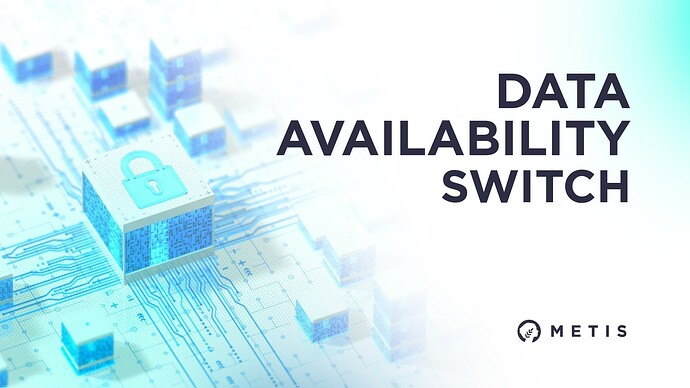Author: Metis
Date: 2023-09-27
Summary
Metis proposes to change the method it uses to process transactions from Layer 1 Ethereum – from an off-chain storage layer to convert to its original traditional Optimistic Rollup format.
Motivation
In the spring of 2022, Metis partnered with a project called Memo Labs to create an off-chain storage layer. This storage layer has enabled Metis to avoid having to push all data to Layer 1 Ethereum; fewer data pushed to Ethereum has led to lower cost to transact on the Metis Layer 2 network.
Migrating to an Optimistic Rollup architecture will simplify the launch of a breakthrough venture: the Metis sequencer pool. Pushing all transactions to Ethereum streamlines the entire process, which would make it easier for Metis developers to launch this sequencer pool.
An important function of Optimistic Rollups is a concept known as data availability. Data availability ensures that the network’s transaction data are available to be reconstructed by validators and users at any time. This is typically done by batching transaction data to Layer 1.
Relying on a third party such as Memo Labs can have an adverse impact on data availability, as not all transaction data are published to Layer 1 – only the location of the data stored in Memo Labs. Migrating to Metis’ original Optimistic Rollup format would mark a heightened commitment to data availability, and to Ethereum’s ethos, while still enabling transaction fees that are in line with other Layer 2 networks, and much less expensive than on Layer 1 Ethereum.
Metis Sequencer Pool
Metis will soon become the first Layer 2 network to decentralize its sequencer by launching a first-of-its-kind sequencer pool. Opening up sequencer duties to many independent parties would eliminate the single-point-of-failure risk that a single sequencer entails.
By decentralizing sequencer duties across a much broader network, Metis will move beyond the industry standard of relying on a single sequencer entity, ensuring continuity of operations, robust network performance, and enhanced security. It will propel Metis closer to achieving the three challenges of what Ethereum co-founder Vitalik Buterin called the Blockchain Trilemma: decentralization, security, and scalability.
The sequencer pool will also bring new opportunities to Metis users. It will enable single-staking opportunities for METIS previously unavailable on our Layer 2 network; to become eligible to be a sequencer, interested parties will need to stake METIS.
To make that sequencer pool and the opportunities that it will bring possible requires high levels of data availability and simplicity – higher than what is currently available under the existing off-chain storage layer model. Migrating to the Optimistic Rollup model would address both of those challenges.
Community Implications
This move does come with a drawback: transaction fees would go from being lower than on any other Layer 2 network thanks to the Metis Smart Layer 2 approach, to being in line with other L2s. The Metis community could, at a later date, propose that Metis return to its Smart L2 approach after we launch and successfully roll out the sequencer pool. Note that for any such move to be considered, additional steps would need to be implemented to ensure optimal levels of data availability and security.
The need to retain Optimistic Rollup architecture would drop once the sequencer pool is up and running, since the initial challenges of (primarily) simplicity and (secondarily) data availability required would have already passed. If Metis switches to Optimistic Rollup architecture and then retains that format, the call data pushed to Memo Labs in the past would require an extra step to access. This would not impact on-chain transaction verification, user experience, or the smooth operation of the network.
However, a blockchain is typically designed to make records of all data easily accessible to anyone who wants to go back and review any network activity. The community could ask Metis to provide a snapshot enabling easier access to all historical call data, complete with timestamps and other key details. Then after Ethereum migrates to EIP-4844, the community could propose that Metis evaluate the developer time and cost required to upload historical call data from Memo Labs to Ethereum, and decide how to proceed from there.
For now, though, the proposal before the community is a simple YES or NO (or ABSTAIN) on Metis migrating to Optimistic Rollup format to support full data availability.
Main Advantages for converting to Optimistic Rollup format
– Removes a layer of complexity in Metis architecture, thus facilitating the successful launch of the sequencer pool.
– Enables full data availability, which would help the launch of the sequencer pool.
– Sequencer pool will enable Metis to stop relying on a single entity to handle sequencer duties for the entire network, enabling more decentralization and security upgrades.
– Sequencer pool will enable single-staking opportunities for METIS not currently available in the ecosystem.
Main Disadvantage for converting to Optimistic Rollup format
– Would move transaction costs from lowest among all Layer 2 networks to in line with other L2s, pending a possible switch back to Smart L2 format once the sequencer pool is operational.
Next Steps
- Gather community feedback on this proposal.
- Once consensus is reached, move this proposal to the Snapshot stage for a community vote.
- If the Snapshot outcome is 51% YES, implement the proposed changes to Metis’s Data Availability, migrating it back to Ethereum Mainnet
